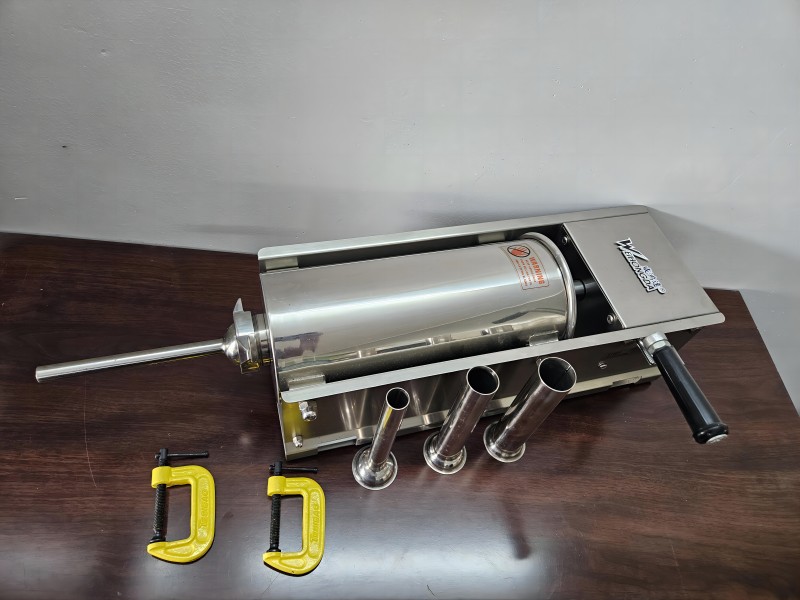Sosis Yapımına Giriş
Ev yapımı sosis yapmak hem yemek meraklıları hem de ev şefleri arasında popüler bir trend haline geldi. Bu sadece yemeği kendiniz hazırlamanın verdiği tatminle ilgili değil, aynı zamanda malzemeler, lezzet ve kalite üzerinde sağladığı kontrolle de ilgilidir. İster geleneksel tarifler yaratmak ister yeni tatlar denemek isteyin, evde sosis yapmak mutfak olanakları dünyasının kapılarını açar. Koruyucu maddelerden kaçınabilir, tercih ettiğiniz et kesimlerini seçebilir ve baharatlarla yaratıcılığınızı konuşturabilirsiniz. Ancak başlamak için doğru araçlara sahip olmak çok önemlidir. Bunların arasında sosis yapma makinesi sürecin kolaylaştırılmasında çok önemli bir rol oynar.
Sosis Yapım Makinelerini Anlamak
Bir sosis yapma makinesi, sosis yapma yolculuğunuzun bel kemiğidir. Bu makineler, sosis kılıflarını doldurma ve et karışımının eşit şekilde dağılmasını sağlama görevini basitleştirir. Sosis yapma makinelerinin iki ana tipi vardır: manuel ve elektrik.
- Manuel Sosis Makineleri daha gelenekseldir ve et karışımını kılıfların içine itmek için elle kranklama gerektirir. Süreç üzerinde daha fazla kontrol sunarken, aynı zamanda daha fazla fiziksel çaba gerektirirler.
- Elektrikli Sosis MakineleriÖte yandan, otomasyon ve kolaylık sunarak daha büyük partiler veya sık sık sosis yapımı için idealdir. İş yükünü azaltırlar ve manuel makinelere göre daha hızlı sosis üretirler.
Her makine tipinin ihtiyaçlarınıza, bütçenize ve ne sıklıkla sosis yapmayı planladığınıza bağlı olarak avantajları vardır.
Sosis Yapımı için Temel Ekipmanlar
Sosis yapma makinesi hayati önem taşısa da, en iyi sonuçları elde etmek için diğer ekipmanlar da aynı derecede önemlidir. İşte başarılı bir sosis yapımı için sahip olunması gereken araçların bir dökümü:
- Et Öğütücü: Her şey burada başlıyor. Etin doğru kıvamda öğütülmesi sosis yapımı için çok önemlidir. Kaliteli bir öğütücü eşit doku sağlar ve tıkanmayı önler. Çok yönlülük için farklı plaka boyutları sunan bir öğütücü arayın.
- Sosis Doldurucu: Et öğütüldükten sonra, bir sonraki adım onu kılıflara doldurmaktır. Sosis doldurucuların da tıpkı sosis makinelerinde olduğu gibi manuel ve elektrikli versiyonları vardır. Sağlam bir yapıya ve birden fazla başlık boyutuna sahip olanı seçmek, size farklı sosis türleri yapma konusunda esneklik sağlayacaktır.
- Karıştırma ve Çeşnilendirme Araçları: Doğru baharatlama, lezzetli sosislerin anahtarıdır. Baharatların ve malzemelerin eşit dağılımını sağlamak için karıştırma kaseleri, kaşıklar ve baharat kapları kurulumunuzun bir parçası olmalıdır.
- Sosis Kılıfları: Kılıflar doğal (hayvan bağırsaklarından elde edilen) veya sentetik olabilir. Doğal kılıflar geleneksel bir doku ve lezzet sağlarken, sentetik kılıflar tutarlılık ve dayanıklılık sunar. Seçim genellikle kişisel tercihe bağlıdır.
Süreci Geliştiren Ek Araçlar
Temel aletlere ek olarak, bazı ek ekipmanlar sosis yapma deneyiminizi daha da geliştirebilir:
- Dijital Termometre: Sosislerin güvenli bir şekilde yenebilmesi için doğru sıcaklıkta pişirilmesi gerekir. Dijital termometre, sosislerin iç sıcaklığını izlemenize yardımcı olarak her seferinde mükemmel sonuçlar elde etmenizi sağlar.
- Mutfak Tartısı: Sosis yapımında, özellikle de malzemeleri ölçerken hassasiyet çok önemlidir. Bir mutfak terazisi, dengeli bir lezzet profili için doğru miktarda et, yağ ve baharat eklemenizi sağlar.
- Gıda İşlemcisi: Sosis yapımı için kıyma makinesi kullanılsa da, mutfak robotu sosis karışımınıza girecek sarımsak, soğan ve otlar gibi malzemeleri hazırlamak için çok yönlü bir araç olabilir. Zaman kazandırır ve homojenlik sağlar.
Sosis Yapma Makinesinin Temizliği ve Bakımı
Ekipmanınızın bakımı, onu doğru kullanmak kadar önemlidir. Sosis yapımı çiğ et içerdiğinden, kontaminasyonu önlemek ve gıda güvenliğini sağlamak için hijyen çok önemlidir.
- Sosis Yapma Makinelerinin Temizlenmesi: Her kullanımdan sonra makineyi sökün ve tüm parçaları iyice temizleyin. Öğütücü plakalarına ve doldurma borularına özellikle dikkat edin, çünkü et parçacıkları bu alanlarda sıkışabilir.
- Diğer Aletleri Temizlemek için İpuçları: Karıştırma kaplarını, kaşıkları ve termometreleri dezenfekte ettiğinizden emin olun. Elektrikli makineleri temizlemek için her zaman üreticinin talimatlarına uyun, çünkü su doğru kullanılmazsa motora zarar verebilir.
Düzenli bir temizlik rutini ekipmanınızın ömrünü uzatacak ve sosislerinizin her zaman güvenle yenebilmesini sağlayacaktır.
Doğru Sosis Yapma Makinesini Seçmek
Doğru sosis yapma makinesini seçmek, mevcut çeşitli modeller göz önüne alındığında çok zor olabilir. Ancak birkaç temel faktöre odaklanmak karar vermeyi kolaylaştırabilir:
- Boyut ve Kapasite: Ne kadar sosis yapmayı planladığınızı düşünün. Daha küçük makineler ara sıra kullanım için harikayken, daha büyük modeller sık sosis yapanlar veya büyük partiler yapanlar için daha uygundur.
- Özellikler: Ayarlanabilir nozullar, hız ayarları ve kullanım kolaylığı gibi ek özellikleri göz önünde bulundurun. Bazı makineler, farklı boyutlarda sosis yapmak için ataşmanlarla birlikte gelir ve kreasyonlarınızda size çok yönlülük sağlar.
- Bütçe ve Marka Önerileri: Sosis yapım dünyasında tanınmış bazı markalar arasında LEM, STX International ve Weston bulunmaktadır. Bu markalar, bütçe dostu seçeneklerden profesyonel sınıf ekipmanlara kadar çeşitli makineler sunmaktadır. Hem bütçenize hem de ihtiyaçlarınıza uygun bir makine seçin.
Sonuç: Sosis Yapım Yolculuğunuz Burada Başlıyor
Doğru ekipman, başarılı sosis yapımının temelidir. Kıyma makinesinden sosis doldurma makinesine kadar her bir alet, sürecin sorunsuz, verimli ve keyifli olmasını sağlamada çok önemli bir rol oynar. Doğru sosis yapma makinesi ile bu ödüllendirici mutfak sanatına dalabilir, tatları deneyebilir ve ev yapımı kreasyonlarınızla arkadaşlarınızı ve ailenizi etkileyebilirsiniz. Sosis yapma makinesi mutfakta sonsuz olasılıkları keşfetmenizi sağlar ve doğru araçlara sahip olmak yolculuğunuzu hem kolay hem de eğlenceli hale getirecektir. Öyleyse neden bugün başlamıyorsunuz?
Sosis Yapma Makinesi Hakkında SSS
- Yeni başlayanlar için en iyi sosis yapma makinesi türü nedir?
Yeni başlayanlar için elektrikli sosis makinesi, kullanım kolaylığı ve verimliliği nedeniyle genellikle en iyi seçimdir. Manuel çabayı en aza indirir ve süreci hızlandırır. - Zaten bir sosis doldurucum varsa kıyma makinesine ihtiyacım var mı?
Evet, et karışımını hazırlamak için kıyma makinesi şarttır. Sosis doldurucular sadece kılıfları doldururken, kıyma makineleri etin düzgün bir şekilde kıyılmasını ve karıştırılmasını sağlar. - Ev yapımı sosisler ne kadar süre saklanabilir?
Taze ev yapımı sosisler buzdolabında 3 güne kadar saklanabilir veya 3 aya kadar dondurulabilir. Tazelik için sosislerinizi etiketlediğinizden ve tarih attığınızdan emin olun. - Makine olmadan sosis yapabilir miyim?
Mümkün olsa da, makine olmadan sosis yapmak yoğun emek gerektirir. Manuel bir doldurucu veya geçici bir huni kullanmak işe yarayabilir, ancak bir makine ile aynı tutarlılığı sağlamayacaktır. - Sosis yapımı için hangi baharatlar gereklidir?
Yaygın baharatlar arasında tuz, karabiber, sarımsak, kırmızı biber ve rezene tohumu bulunur. Ancak kullandığınız baharatlar, yaptığınız sosisin türüne ve kişisel damak tadı tercihlerinize bağlı olacaktır.

